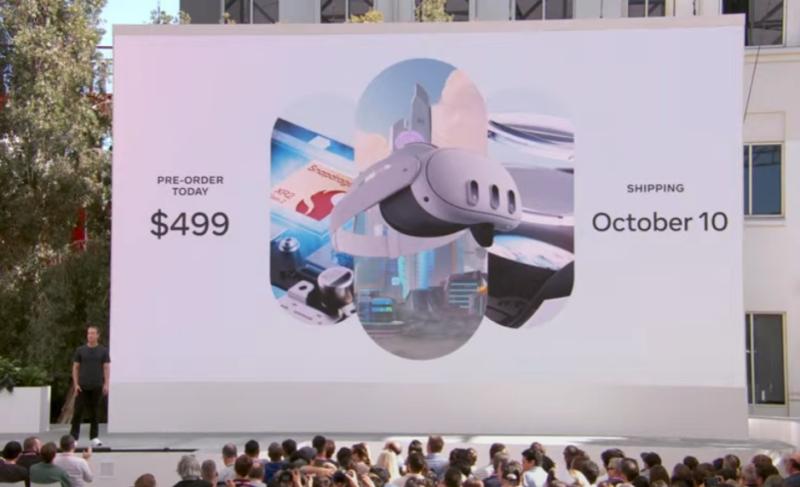
Following a small tease in July, Meta has announced an October 10 release date for its Quest 3 headset. The follow-up to 2020’s hot-selling Quest 2 and 2022’s overpriced Quest Pro will start at $499 for a 128GB model or $649 for a 512GB model.
The lower-end model comes bundled with a copy of Asgard’s Wrath 2 (available in winter 2023), while the higher-end model also includes a six-month subscription to the Meta Quest+ software subscription service.
The new headset upgrades the Snapdragon XR2 line powering previous Quest headsets to a “Gen 2” chipset, according to specs posted online. That means double the processing power and 30 percent more total resolution than Quest 2 (2064×2208 pixels per eye; 25 pixels per degree). The Quest 3 also sports 8GB of RAM, up from the 6GB of the Quest 2 but down from the 12GB on the Quest Pro.
The Quest 3 also mimics the Quest Pro’s “pancake optics,” which allow for a sharper edge-to-edge display in a shape that’s 40 percent thinner than the Quest 2. But the headset is lacking the internal cameras that allow the Quest Pro to track a user’s eyes.
The headset’s 515 g weight is comparable to the 503 g of the Quest 2 but much lighter than the 722 g Quest Pro. And the new headset’s 100-degree horizontal field-of-view is comparable to the 104 to 108 degrees measured on previous Quest headsets.
Two trackable “Touch Plus” controllers included with the headset mimic the ring-free design of Quest Pro controllers. Meta promises anywhere from 1.5 hours of battery life when using “productivity” applications and up to 2.9 hours when simply viewing passive media. An included 18 W charger and dock should charge the headset fully in 2.3 hours, Meta says.
The headset is also fully backward compatible with over 500 titles designed for earlier Quest headsets, and it can be connected to a PC via Link Cable or Air Link wireless connection for PC VR experiences.
A mixed reality focus
While immersive virtual reality content is still a focus for the Quest 3, Meta CEO Mark Zuckerberg went out of his way to stress that this will be “the first mainstream mixed reality headset,” allowing you to “blend the physical and digital worlds together.” That’s thanks to hand-tracking that’s getting “really good”—enabled by four outward-facing infrared cameras—and an automatically mapped view of the room around through two high-resolution (18 pixel-per-degree), full-color passthrough cameras and a depth sensor.
This means you’ll be able to throw a virtual ball and see it bounce off your real wall, Zuckerberg said, or duck behind a couch to avoid incoming fire in a shooter. It’ll also let you place virtual 2D screens that float in your view of a physical room and then use those screens for everything from watching a basketball game to playing Xbox cloud gaming titles (starting in December) or using Microsoft 365 productivity apps (starting next year).
By next year, Meta says it will also offer a series of what it calls “Augments” that you can anchor in place to decorate your virtual spaces. These could range from a video picture frame that hangs on a wall to a digital portal that hangs next to your real-world workout gear.
“It understands your space so you can play with the world around you,” Zuckerberg said of the headset, which he sees as the first step to a sort of hybrid digital/physical version of a telepresence metaverse. In the future, “you’ll be there physically with some of your friends and others will be their digitally as avatars, or holograms, and will feel just as present,” Zuckerberg said.









